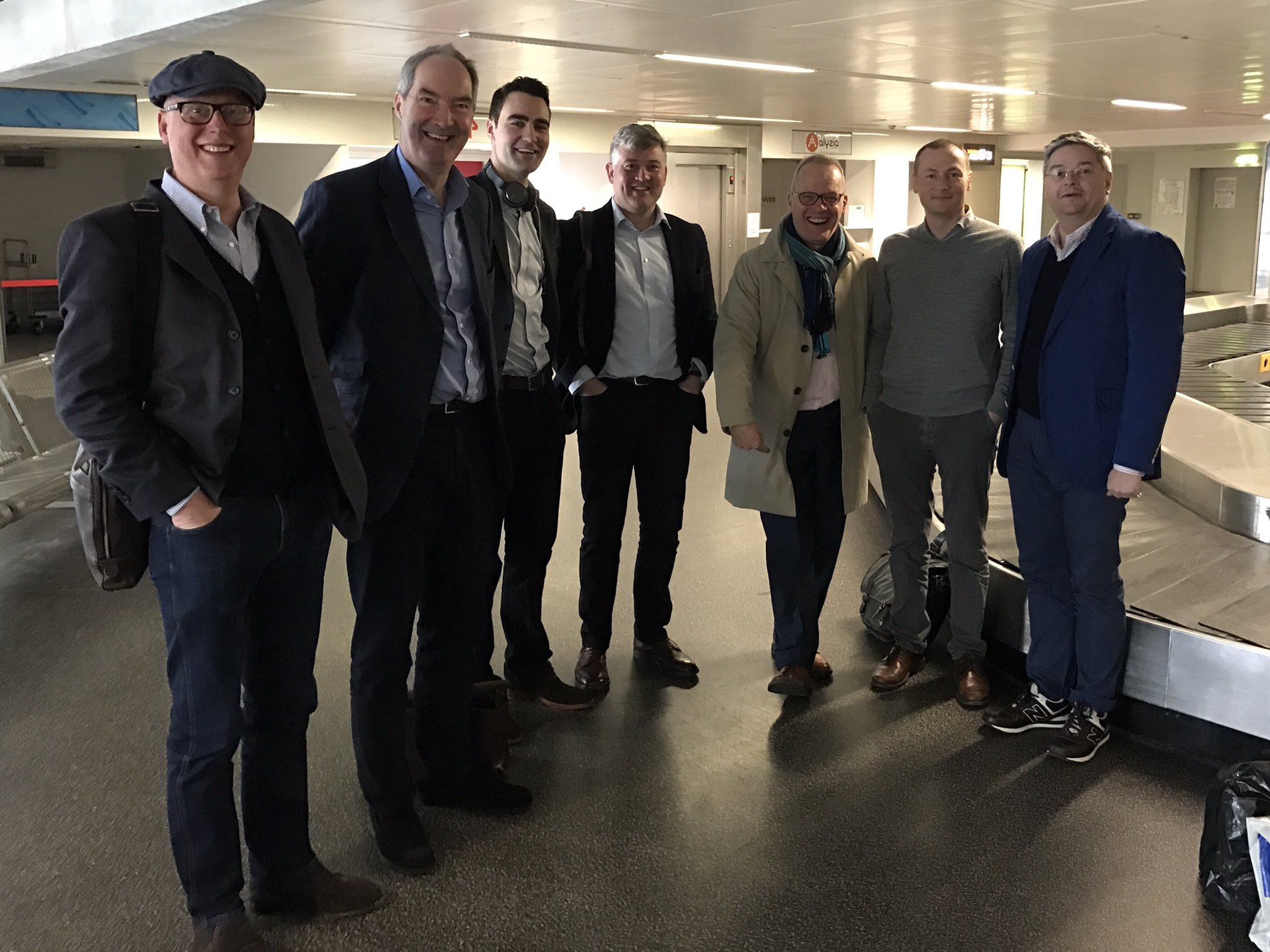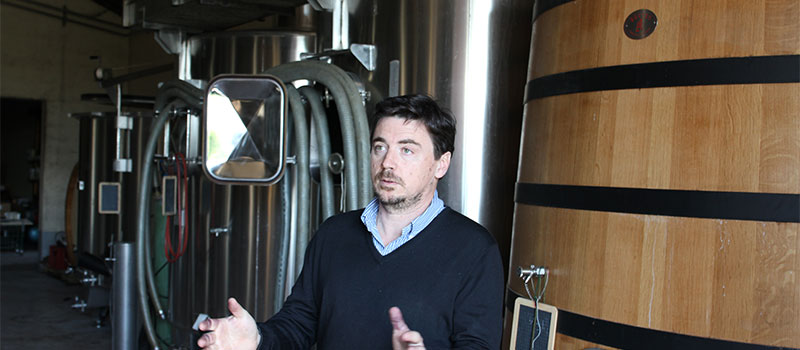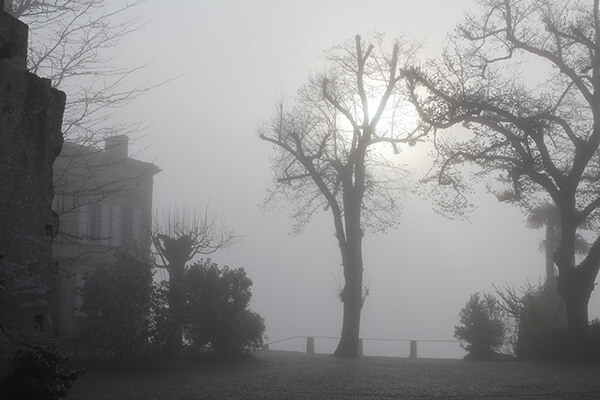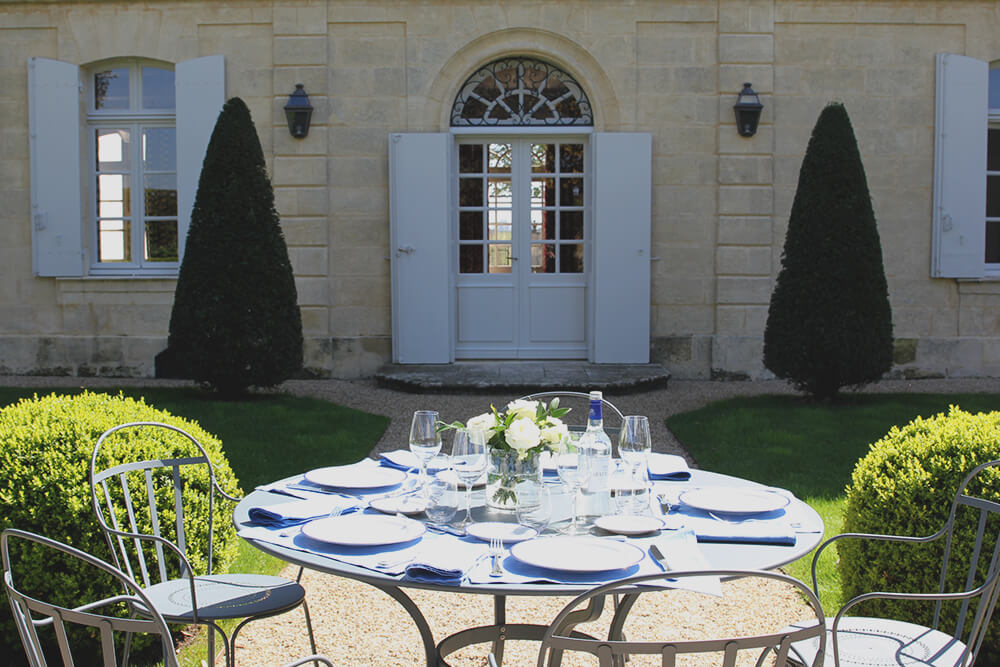Day 1: First Impressions
This was my first primeur campaign so excitement was trumping exhaustion as we boarded the 06:30 flight to Bordeaux. Some startling efficiency at head office meant that we were sitting at the front of the aircraft (at no extra cost I might add!). This did not go unnoticed by the troop of journalists and industry grandees on our flight who had not been quite as efficient. Tim Atkin seemed especially put out. Jealousy is a cruel mistress.

Six wine merchants and a wine journo on arrival in Bordeaux, and would you believe not a pair of red trousers between them…
Still slightly bleary eyed, we jumped straight into our first appointment – a big négociant tasting. Not all the top wines were represented but it was nonetheless a really useful barometer for the vintage as a whole and a great opportunity to compare and contrast some carefully chosen back-vintages.
What did we think?
Well, as many others have said, this vintage was a joy to taste en primeur. There is a lovely ripe, sweet, sappy juice that makes these wines eminently drinkable. The best also have a lively acidity which helps to retain energy, clarity and freshness. There is nothing frivolous about the vintage though. Many IPTs (indexe de polyphenoles et tannins) are up in the 80s and 90s. It’s just that those tannins are so beautifully ripe and rounded that the characteristic juiciness of the vintage isn’t overwhelmed by all that structure.
Having said all that, this vintage isn’t 2005, 2009 or 2010. The wines just aren’t quite as profound, quite as deep, quite as grandiose. This is more in the style of the elegant vintages of the 1980s and 1990s before new winemaking techniques, fashions and warmer growing seasons made wines with more power, alcohol and structure. Arguably this is actually more ‘traditional’ in style, more of what Charles wisely terms ‘Englishman’s Claret‘. It’s none the worse for it.
The tasting as a whole was very impressive and it did show that there are some spell-binding wines in 2016. In no particular order, Canon, Rauzan Ségla, Malescot St Exupéry, Brane Cantenac, Smith Haut Lafitte, Montrose, Léoville Barton and Calon Ségur all shone very brightly indeed.
We also left with the impression that the sheer juiciness of this vintage means that some of the ‘lesser’ wines should punch well above their weight. Again, in no particular order, we were hugely impressed by La Mauriane, Moulin Haut Laroque, Clos Manou, Charmail, Le Coteau, Paloumey, Sénéjac, Belgrave and La Garde. Second wines too should (hopefully!) offer great value. Ségla, Croix Canon, Sarget de Gruaud Larose, Fiefs de Lagrange and Dame de Montrose were all top drawer in their own right.

Pierre Taix, La Mauriane
After the négociant tasting we jumped back in the car and headed over to the right bank for one last appointment with Pierre Taïx at La Mauriane. The feel of things is different up in Puisseguin. There are no Porsches in the driveways. There are no glossy brochures. The caves and chais feel more like workshops than conference centres.
Mauriane itself is perched on top of the same deep limestone outcrop that pops up in the village of Saint Emilion. Like a shirt through a tattered sweater, you can actually see the white rock glistening through the topsoil. It sounds silly but you can almost sense what a struggle it must be for the vines to take root here.
Pierre himself is a passionate proponent of authenticity in his wines. He bemoans the fact that Merlot was so widely planted in the 60s and 70s at the expense of more indigenous varieties like Cabernet Franc and Petit Verdot. He is also adamant that thermo-vinification (heating must to 80C for a short period) removes varietal expression and damages delicate aromatics, particularly that green vegetal character born of natural pyrazines that lend Bordeaux what he describes as an ‘Atlantic’ personality.
These passions shine through in his 2016. There is an astonishing purity to the purple berry aromatics. The fruit has tremendous succulence without ever being heavy and it is all given tremendous drive and lift by that inimitable core of limestone minerality. We can’t recommend it highly enough. When we asked him what he thought of it, Pierre was typically understated.
He just said, “bons raisins, bon vin.”
I assure you there is more to it than that!
Day 2: Pomerol & Saint Emilion
The morning mist was very slow to lift on Monday so we appeared at our first appointment at a particularly atmospheric Château Ausone. We were very impressed by the whole stable here but Fonbel and Moulin Saint George should offer good value, while the Chapelle d’Ausone offers plenty of the essence of the grand vin without quite such an eye-watering price-tag.
Next it was on to Cheval Blanc. Tasting in their stunning new winery is certainly a world away from Puisseguin. The grands vin here was perhaps showing a little quiet and closed – aloof even. It’s like the wine knows just how spectacular it’s going to be and it feels absolutely no need to grandstand to us.
We were just heading out when a suitably glamorous lady asked… “Would you like to proceed to the Orangery for some Yquem?” If only I was asked that a little more frequently!
We were then presented with a chart containing so much data on rainfall, ripeness and a bewildering array of ‘tris‘ (harvest sweeps through the vineyard) that I was left thinking that Yquem clearly operates in a slightly different space-time continuum. Perhaps that was the point. Anyway, tasting it was proof enough. It does.

Morning mist at Ausone
The wines of Denis Durantou were next in the firing line. This stable is astonishingly dependable and 2016 proved no different. Denis describes 2016 as, “the revenge of the Merlot.” These wines certainly showcase it at its very best. It’s hard to exaggerate quite how good the La Chenade, Les Cruzelles, Montlandrie and Petite Église are in this vintage. La Chenade and Les Cruzelles will be ready almost right out of the gate, the Montlandrie and Petite Église will reward more patience.
L’Eglise-Clinet itself is clearly in another galaxy in terms of quality but the prices aren’t likely to be all that down to earth so it will probably be one for the high flyers. As we left, we spotted that case quantities were supplied for all bar the grand vin. The tech-sheet just said, “not enough.” Too true.
Our grand tour across the Pomerol plateau then took us to Le Pin where we tasted in front of a wonderfully ornate tapestry which the charming Mr Thienpont seemed rather embarrassed to have “won” after putting in a “crazy bid” (by implication inadvertently!?) at auction. This artistic flourish was somehow appropriate for Le Pin and L’If. These are two wines of extraordinary grandeur and sensuality – baroque some might say?
On to Tertre Rôteboeuf where we arrived to find the resplendent François Mitjavile in a buoyant mood. With a broad grin, he sparked a short debate about whether we should converse in French, English, or “L’Anglais de Eton.” I assure you, François is impressively fluent in all three.
The wines from this stable are profound, muscular and concentrated. They are not for the faint-hearted. This power isn’t engineered though, like some from this appellation. It is a natural force born of François’ exceptional terroir and not of his winery. They are some of the best we tasted in the appellation.
We left to a rather lengthy lecture on white asparagus and some tongue-in-cheek words about the inferiority of “La cuisine Britannique.” Just as well we were heading to Canon for lunch!

Ready for Lunch at Château Canon
After sampling Canon at the négociant tasting the day before we had high hopes. It did not disappoint. We walked from the tasting room to our delightful luncheon in the spring sunshine rather unable to contain our enthusiasm for what is quite clearly one of the wines of the vintage. It has purity, elegance and freshness teamed with breadth, power and drive. Nicolas Audebert is doing great things here.
After lunch it was L’Évangile and Figeac which were two real show-stoppers. These were big wines but they didn’t lose any flow or polish. I was utterly beguiled by their texture and the richness of the fruit.
Angélus was next. In its style it is a very good wine and certainly more focused and less bombastic than in some previous vintages. It could just be me but to my mind this still feels just a touch awkward, forced even, like a date slightly lacking in chemistry.
The impressive array of wines from Nicolas and Cyrille Thienpoint at Pavie Maquin were up next. We were particularly impressed by Puygueraud, La Prade and Alcée as well as Pavie Maquin itself. Many of these should offer very good value.
At La Conseillante we were treated to taste a wonderful 1996 from magnum, reportedly left over from lunch (we must remember to book in here next year). The 2016 was equally delicious. Perhaps it doesn’t have to power of L’Évangile or L’Eglise-Clinet but it certainly oozes elegance and charm.
Pavie’s new complex rather sticks out at the base of Saint Emilion’s limestone plateau. Somehow the foursquare building seems as if it’s become detached and adrift from the outcrop, like Old Harry Rocks. We headed past the antique cars and the Chinese chariot into the grand ballroom to taste. This is slightly more airport lounge or Trump tower than traditional Bordeaux Château but then maybe that’s the idea. I have to admit the wines were a bit of a handful – there were more than a few IPTs here. After tasting Clos Lunelles most of us could hardly speak. Perhaps that’s why the tasting room was so eerily quiet and why the cheese cubes were in such high demand.
The last stop for the day was the Malthus stable at Le Dôme. I was suffering from severe palate exhaustion by this point so I probably didn’t do these justice. I found the wines deep, dark, concentrated expressions of Saint Emilion. Some will love that style but I have to admit most of my attention was already focused on the prospect of the refreshing lager Tom Lorimer had promised me in the town’s beautiful central square. It was a 100 pointer.
Day 3: Remaining Right Bank
Day three was spit into two. The morning was spent finishing up on the right bank before we headed back over the Pont d’Aquitaine for some Châteaux-hopping up through Pessac-Léognan and the Haut Médoc.
First stop Clos Fourtet. Here, the first thing that strikes you is the conspicuous plot of fallow land lying just to the right of the beautiful manor house. In all 2.2 hectares are uncultivated, more than 10% of the total vineyard area here! Fungus has been the enemy and it could be as much as 4-5 years before this can be replanted. Getting things absolutely right in the vineyard is clearly a top priority here.
All that work is certainly paying off. The grand vin this year has beautiful elegance, purity and life. It certainly makes it onto our ‘wish-list’ for 2016 Saint Emilion & environs with Ausone, Cheval Blanc, Tertre Rôteboeuf, Canon, L’If and Figeac.
Then came one of the absolute highlights of the day (possibly the whole campaign) – Vieux Château Certan. This was utterly enchanting. It has such a richness but it is still so refined, elegant and precise. It’s pure weightless silk of astonishing poise and length. I sort of imagine this lying comfortably among the opulence of the Court of Versailles or festooned over a Renaissance bazaar. We really did feel that this was among the very best of the right bank.
Next was Clinet – who literally rolled out the red carpet. The grand vin at Clinet was impressive in power and weight. It’s one of those wines you imagine will be near the top of the IPT tables. There’s also quite a bit of new wood here too, and it showed on the nose, but there is plenty of juice to hang it on.
This heralded the end of our right bank adventure and we hopped in the car to head over to the UGC Graves tasting. I was actually rather looking forward to the rest (and to lunch…), you are probably thinking much the same so we will pause here and pick up our journey in Part II to be published next week.
Bonne journée